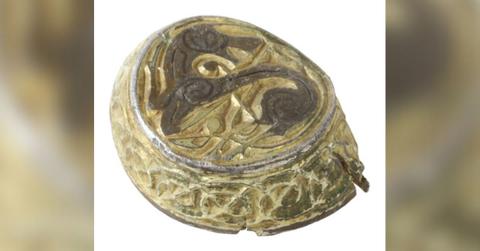Ancient Enigma: Experts Baffled by 1,200-Year-Old Artifact Found in England — Can You Solve the Mystery?

A meticulously crafted Anglo-Saxon artifact discovered in the United Kingdom is stumping archaeologists who are unsure of who made it and why.
Archaeologists in the United Kingdom are grappling with the mystery of a finely crafted artifact, the origins and purpose of which remain elusive.
Unearthed in Rutland, England, by a diligent treasure hunter using a metal detector, the enigmatic Anglo-Saxon item is thought to hail from the 8th or 9th centuries, according to Artnet News.
Designated as an "unidentified object made from silver" by The Portable Antiquities Scheme (PAS), a platform documenting public archaeological discoveries in England and Wales, the relic boasts an Early Medieval and Anglo-Saxon style.
It is partially gilded and adorned with niello, a black metallic alloy featuring sulfur, silver, copper or lead, commonly used to fill engraved designs in metal, as described by Brittanica.
The purpose of this intriguing find remains shrouded in uncertainty, yet its composition, comprising over 10% precious metal, has led experts to conclude it is more than three centuries old. Therefore, it falls within the category of "potential treasure" under the United Kingdom's Treasure Act of 1996, PAS stated.
Described on the PAS website as a unique object with a shape that defies easy classification, weighing a mere 5.8 grams (equivalent to a pencil), and measuring approximately 20 millimeters in diameter with 8.5 mm depth and 1 mm thick walls, the artifact presents a flat circular top and short sides forming a hollow cylinder. One side exhibits a notable inward bend, resulting in a deep crack.
Helen Geake, a historian, expressed awe at the meticulous craftsmanship, emphasizing the object's diminutive size in comparison to the meticulous attention it received during creation, akin to that dedicated to crafting a Bible or a piece of jewelry, BBC News reported.
Never miss a story — sign up for the Front Page Detectives newsletter. Be on the scene the moment news breaks.
The artifact features an intricate design portraying an animal, possibly a horse, characterized by an open mouth and "spiral hips enmeshed in chip-carved interlace," according to information provided on the PAS site.
Notably, the “chunky proportions and large eye” differ from the conventional late 8th-century Mercian style.
Become a Front Page Detective
Sign up to receive breaking
Front Page Detectives
news and exclusive investigations.
